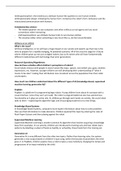Anthropomorphism: the tendency to attribute human-like qualities to non-human entities
Anthropomorphic design: imitating the human form. Comprises the robot’s form, behaviour and the
interaction/communication with humans.
Complementary visions:
- The media equation: we see computers and other artifacts as real agents and use social
conventions when interacting
- Anthropomorphism: we attribute human traits to non-human entities
- The uncanny valley: when something is very much like us, we feel uncomfortable
Williams et al. (2019)
What’s the issue?
Artificial intelligence, or AI, will have a huge impact on our society and experts say that now is the
time to prepare for a rapidly-changing, AI-powered economy. All of this sets the stage for a future
where children grow up not just as digital natives, but as AI natives who will have fundamentally
different relationships with technology than prior generations
Research Questions/Hypotheses:
How do these activities affect children’s perceptions of robots?
Social robots interact with people in more human-like ways: speech, non-verbal cues, gaze, emotive
expressions, etc. However, younger children are still developing their understanding of "what it
means to be alive" making their attributions less consistent across the population than their older
counterparts.
How much can children understand about the different types of AI (knowledge-based, supervised
machine learning, generative AI)?
PopBots
PopBots is a platform for programming lego robots. Young children learn about AI concepts with a
visual interface (since they can’t yet read). The robot is programmable but also has autonomous
functionality as it plays an active role. As children go through each hands-on activity, the social robot
talks to them – explaining the algorithm logic and encouraging students to try new things.
Knowledge-Based Systems
In Knowledge-Based Systems, computers store expert information about how to solve problems
then use that information to make decisions. Children explored this topic by entering the rules of
Rock-Paper-Scissors and then playing against the robot
Supervised Machine Learning
Supervised Machine Learning is another common AI algorithm that involves acquiring a knowledge
base from examples. In our activity, children are introduced to training sets and how robots learn
patterns by labelling a subset of foods as healthy or unhealthy, these foods form the training set.
Generative AI
Generative AI is very different from the other two topics. Rather than learning rules, the system
generates a new output based on children’s input song, within the bounds of parameters the child
gives it. In PopBots, children explore how a robot creates a new melody by changing the tempo and
progressions of an input melody by the child.
, Theory of mind
Knowledge access: (“Understanding that seeing leads to knowing”) – not seeing leads to not
knowing.
False belief: sometimes people believe things that are not true, and they act according to their
beliefs, not according to what is really true.
Results
- Performing the programming tasks for the three AI concepts helps children to understand the
technology and develop theory of mind.
- Young children understand knowledge-based systems best, followed by supervised learning,
then generative AI.
Conclusion
It's worth teaching young children about AI already, not only because it helps them understand the
technology better, but it also helps them develop “theory of mind”.
Mirnig et al., 2017
What’s the issue?
“One aspect we know from HHI is that imperfections make human social actors more likeable and
more believable. The psychological phenomenon Pratfall Effect states that people's attractiveness
increases when they commit a mistake.” “We think that because most research focuses on perfect
interaction, many potentially crucial aspects are overlooked.”
Why should we care?
Making more realistic, relatable social robots.
Research Question/Hypotheses
1. A robot that commits errors during its interaction with humans is perceived as more likeable
than a robot that performs flawlessly
2. A robot that commits errors during its interaction with humans is perceived as more
anthropomorphic than a robot that performs flawlessly
3. A robot that commits errors during its interaction with humans is perceived as less intelligent
than a robot that performs flawlessly
Study Design
- Between subjects
- Comparison of two different conditions
- Participants assigned to one of two conditions : a control condition (no errors) and an
experimental condition (with errors, 8 in total)
- Two types of errors :
o Technical mistakes ( stuttering voice, word repetition )
o Breaking with social convention (“throw the blocks on the floor ”)
Results
The following hypothesis was accepted: A robot that commits errors during its interaction with
humans is perceived as more likeable than a robot that performs flawlessly.
Conclusion
“We recommend that robot creators design social robots with their potential imperfections in
mind.”





